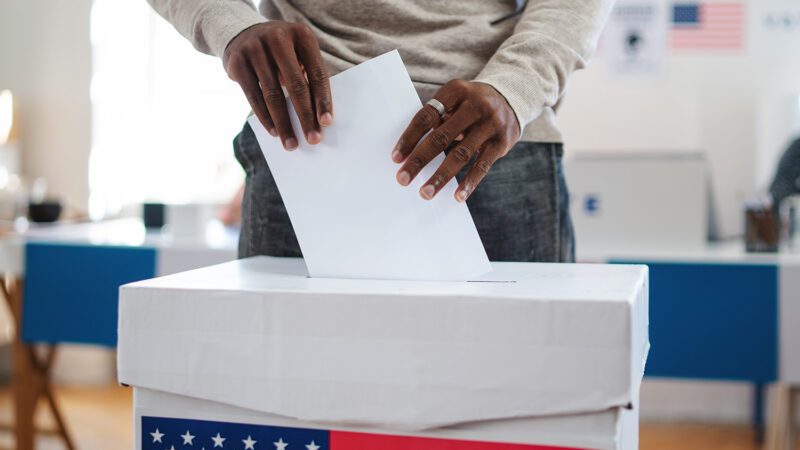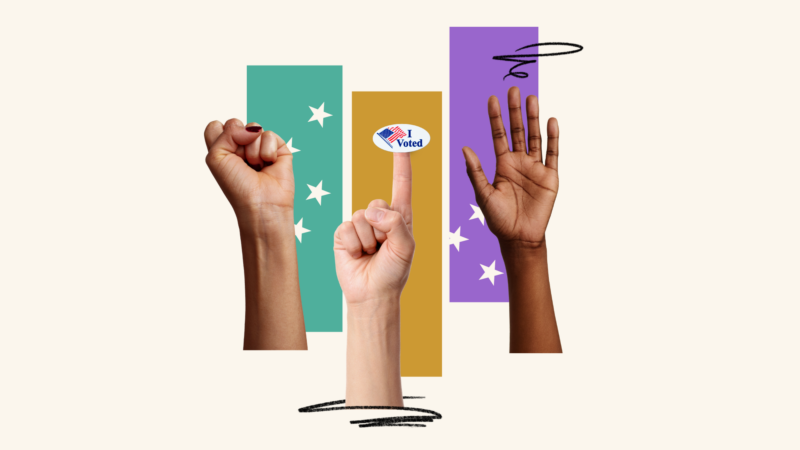Proportional representation and polarization
- September 12, 2023

The United States stands out among Western democracies for its extreme partisan political polarization. It has reached the level of “pernicious polarization,” by which I mean a division of society into two mutually distrustful political camps that harms democracy. In fact, among expert ratings of this kind of polarization, the United States is closer to younger and less wealthy democracies like Brazil and India than to countries like the UK and France. Importantly, Americans are not so divided on the issues themselves — there is broad support for middle-of-the-road compromises on even contentious moral issues like reproductive choice and gun safety. But the two major parties have each become more and more homogenous in their views, and elected officials have grown further apart and less willing to compromise.
In pernicious polarization, polarizing candidates and elected officials adopt an electoral strategy of painting the other side as an existential threat that must be vanquished, rather than a normal adversary who may win this time around or may serve as a constructive opponent. In presenting the other side as uniformly evil and threatening, polarizing candidates erase the option of later bipartisan compromise or consensus, because the voters now view compromise as “selling out” their own principles and interests, and even as traitorous to the nation. Surveys show that these messages get through, as Americans today who identify with either Republicans or Democrats distrust the opposing party and perceive it as an existential threat to an unusually high degree, making every election a high-stakes affair.
The United States is also exceptional among Western democracies in its electoral system — the way we elect members to the House of Representatives, the indirect election of the President through the Electoral College, and the powerful role of the Senate. Together, these institutional characteristics of our democracy grant a representational advantage to more rural and less populous states in choosing the President and members of the Senate. And because the United States is one of only three major Western democracies (and the only presidential system) that elect lawmakers through single-member districts (one representative per geographic district), every district presents a winner-take-all type of election.
Is there a relationship between a country’s electoral system and its degree of political polarization? Recent research comparing democracies around the world indicates that there is — majoritarian systems like single-member districts (SMD) tend to have higher “us-versus-them” polarization than more consensus systems like proportional representation, in which representatives are chosen based on the actual share of votes their party receives in a given district, each of which will have two or more seats to fill. This does not necessarily mean the electoral system causes polarization, and certainly the way we vote is not the sole cause; likewise, changing the electoral system alone will not guarantee a more harmonious state of political affairs. But changing it is likely to help for several reasons.
First, extreme polarization splits a society into two political camps around a single dividing line. That line usually divides people based on party or whether they are for or against a particular leader. That political identification then lines up with views — such as the preferred type of economic system, who should be a rightful citizen, and the role of religion in public affairs — and with other identities like race, religion, gender, geographic place, and more.
In the United States, the single-member district electoral system facilitates us-versus-them political polarization because it encourages a two-party system. Only one party can win, and third parties become wasted votes or spoilers. The rigid, binary choice of parties makes it much harder to break out of pernicious polarization once it arises, because there is no other choice for voters who fear the other party. Elected officials worry that they will be punished by voters if they compromise or vote with the other party, and voters who may not agree with all the positions taken by their own party — or who may even dislike behavior exhibited by their own party leaders that they view as immoral, corrupt, or anti-democratic — cannot bring themselves to vote against their own party if they fear or dislike the other party even more.
Second, in this winner-take-all system, voters who choose a losing party may feel they have no representation whatsoever. When partisan antipathy and distrust are high, these voters may feel increasingly alienated or resentful and may cease to participate in politics or to vote at all. In fact, this general alienation from politics is ripe ground for demagogic figures who promise to “tear the whole thing down” and make decisions on voters’ behalf, without compromising or “selling out” to other interests, and by ignoring democratic or legal constraints.
Third, in single-member districts, district lines drawn by parties are usually gerrymandered to favor whichever party is in power at that time. The result is that safer and safer seats are created, many voters will not have a vote that counts, and it becomes harder to hold elected officials accountable because the chance that they might lose such safe seats is slim. A lack of accountability facilitates corruption and democratic erosion, and polarization can further increase if voters disagree about their concept of democracy or who is the biggest threat to it.
Fourth, the limited choice presented to voters in a highly polarized two-party system means many voters are not choosing who they want to represent them, but who they want to block from coming to power because they fear them (known as the negative partisanship vote). They may remain dissatisfied even if their own party is in power, and fearful and resentful when the opposing party is.
Finally, a binary party system allows extreme factions to capture one or both major parties. When there are only two parties, party leaders cannot isolate and refuse to work with members of their party who are growing more extreme, as they could in a multiparty system. And with negative partisanship, voters are likely to stick with their party even as it becomes more extreme. This too contributes to polarization, perceptions of mutual threat, and support for the erosion of democracy.
How change could help
A different electoral system could help address these problems. Most Western democracies have either a pure proportional representation system (PR) or a proportional system that mixes PR in multimember districts with some single-member seats (mixed-member proportional representation, or MMP). In the multimember districts, voters choose one party or one candidate from a party list, and each party gets the number of seats that equals their proportion of the votes for that district. For example, if Georgia were divided into four districts with three, three, four, and four seats to equal its current 14 seats in the House, then the three parties currently registered in the state (Republicans, Democrats, and Libertarians) would have the possibility of gaining one or more seats in each district if they won a sufficient share of the votes. More parties could also form. Currently, the Republicans and Democrats dominate all of the seats, the Libertarians have not won any representation in Congress, and the Greens cannot even get on the ballot. Examples of pure PR systems are the Scandinavian countries, Spain, Portugal, Israel, Brazil, and Argentina. Examples of mixed proportional systems include Germany, Mexico, and New Zealand.
Changing to a more proportional system could address some of the concerns noted above by:
- giving voters more choice,
- allowing for more centrist parties to arise when the center has dropped out in a polarized system,
- allowing voters to have a representative more in line with their own values,
- reducing or eliminating the opportunity for gerrymandering and making votes count equally,
- reducing the negative partisanship vote, and
- relegating extreme or anti-system views to their own party, usually smaller in size, rather than allowing them to capture one of only two parties in the system.
Learning from abroad
We can learn from other countries that have changed their systems or used proportional representation for a long time. Most European countries use some form of PR, and the Scandinavian countries, which often rank highest on both democracy and happiness and lowest on political polarization, use pure PR. This doesn’t mean they don’t have any conflicts or extreme views, but they are better able to manage them with multiple parties to reflect the different views, and more fluid coalition-building to generate broad support for political decisions.
New Zealand changed wholesale from SMD to MMP in 1996 due to voter dissatisfaction with the disproportionate results of their historical voting system. Voters disliked results in which one party could win a minority of votes but a majority of seats in the parliament. They voted overwhelmingly to change to a system where voters would each have two votes: one for a representative in their own district, and the other for a party. The share of votes that a party receives now determines the total number of seats it gets in the parliament, making the system proportional. After factoring in the number of district seats won by individual candidates in each party, parties fill in from their lists to reach their total proportion.
Polarization can certainly occur in a multiparty system when the political camps are formed by coalitions of parties and/or center around a particular incumbent, with strong antipathy between the pro- and anti-incumbent camps. But having multiple parties and PR allows a variety of views to be represented and enables more fluid coalition building that can break the binary divisions.
How much change is needed?
Would it even matter for polarization if we changed only the method of election in the House while the Senate and Electoral College remained the same? In short, yes. With better representation and more equal weight given to citizens’ votes in House elections, the zero-sum nature of politics could begin to change. Multimember districts mean that even if voters are stuck with just two parties, they would still have a much better chance of feeling represented within their own districts because the districts would no longer be winner-takes-all. PR in House districts would also open the door to encourage more parties to form at the local level and gain representation in the House. Presidents and the Senate majority party would then need to build coalitions within the House to pass their agendas, and eventually the new parties might even gain representation in the Senate.
If states followed by making their legislatures more proportional as well, we could reduce the large number of states where one party truly is the winner who takes all and can entrench itself in power by gerrymandering and regulating elections even when it receives a minority of the votes. Parties are motivated to do this especially when they feel the costs of losing are too high — because they will be shut out completely, or because the opposing party is such an existential threat. Proportional representation within states could open up more opportunities for diverse parties and experimentation, turning the states back into the “laboratories of democracy” they were seen as in the past. And it is the states, after all, that once again will determine how their congressional representatives are chosen if Congress repeals or reforms the 1967 law requiring single-member district elections for the House of Representatives without designating another system to take its place.
It would be ideal to also alter the winner-takes-all nature of most states’ selection of Electoral College delegates and make that process more proportional, and to perhaps consider reforms like ranked-choice voting for Senate elections. Together, such a package, without needing constitutional amendments, would be likely to reduce pernicious polarization by lowering the high stakes of elections that occur in an us-versus-them binary system with perceived existential threats. More proportionate representation is also likely to create a greater sense of fairness, encourage alienated voters to participate, and reduce the possibilities for political minorities or extremists to wield and abuse power.
In the end, no specific electoral system can guarantee all the values that we want to promote — fair representation, effective decision-making, stronger political parties, and reduced hostility and polarization among partisan camps. There are always trade-offs, and agency — the choices that individuals make — is key to making any system work. Would-be political leaders who are willing to pursue polarizing strategies to gain power and seek personal or partisan interests will always exist. And voters may not provide the constraints on power-hungry, divisive, or corrupt leaders that we expect in a democracy: Some are unable to spend the time to become fully informed, participating citizens as they are working hard just to survive, while others may be anxious, afraid, and receptive to the polarizing messages.
But when courageous politicians are willing to support reforms that could make political life much more effective and pleasant, when other societal leaders and groups in the business, academic, faith, and grassroots communities push for commonsense improvement, and when voters themselves start to demand it, we can change the system for the better.
This piece originally appeared in For A Better Democracy: Proportional Representation, a symposium published by Democracy Journal in partnership with Protect Democracy and with support from Democracy Fund.
Related Content
It can happen here.
We can stop it.
Defeating authoritarianism is going to take all of us. Everyone and every institution has a role to play. Together, we can protect democracy.
Donate
Sign Up for Updates Sign Up for Updates
Explore Careers Explore Careers
How to Protect Democracy How to Protect Democracy



